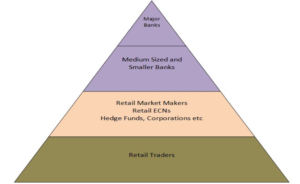What Is Forex Trading Market ?
November 22, 2019
- Forex Market:
1.1 Market Size:
Forex Market is a highly liquid, decentralized market, where it exceeds on average $5.3 Trillion USD per day in total trading, Forex Market consists of two tiers: The Interbank and wholesale market, and client or retail market:
- Approximately 39% of transactions were strictly Interdealer (i.e. interbank).
- Approximately 53% of transactions involved a dealer (i.e. bank) and fund manager or other non-bank financial institution.
- Approximately 9% of transaction were between a dealer (i.e. bank) and a non-financial company.
The Forex Market is dominated by these currencies: USD dominant vehicle currency traded at 88%, EUR is the second being traded at 31%, JPY being third at 22%. The major markets are London, New York and Tokyo.
1.2 Market Description:
Foreign Exchange (Forex) market is an emerging and uprising market with numerous disaggregated players, it has expanded by 35% from 2010 to 2013 reaching an all-time high of $5.3 trillion traded per day, The Forex Market consists of many segments that are explained bellow:

Central BANKS:
- Bank: Large Banks (Institutional players) that are classified as a segment of the inter-banking market which are accountable of 53% of all forex trading, in conclusion they make the major trades in the Foreign Exchange Market.
- Size: Ranging from 8-10 large banks and institutions estimated to be trading in the total daily traded sum of $5.3 trillion dollars.
- Business Model: Twofold: buying and selling currencies to each other as well as to larger corporations who need to exchange their currencies into a different nomination in order to set a price on particular currencies, to which are used for speculation, hedging and currency exchange for international commerce.
- Spread: Low spread on margins (i.e. 1 Pip). Prices are purposively set with less variability than smaller players.
- Regulation: Well-regulated on Forex operations.
Prime Brokers:
- Prime Brokerage: Large capital firms that specialize in providing financial services and Source liquidity from a variety of executing dealers while maintaining a credit relationship, placing collateral, and settling with a single entity to the trading industry.
- Size: Ranging from 15-25 total Prime Brokerage’s trading Forex.
- Business Model: Model is built on practice of rehypothecation. Furthermore, Prime Broker’s Provide hedge funds with the ability to borrow stocks and bonds.
- Spread: Low spread on margins (i.e. 0.2 – 0.4 Pip’s), these spreads are low due to prime brokers offering credit and services to traders who usually trade on ECN’s.
- Regulation: Well-regulated on forex operations.
Prime of Prime:
- Prime of Prime: Secondary Prime Brokerage’s (Capital Firms) specializing in providing services to traders (Forex Traders) who require micro-contract trades. Prime of Prime brokerage’s (PoP) occasionally allow trades of greater leverage, to which it leads to placing greater risk.
(Significant deposit is required to be available in order to access Prime of Prime)
- Size: Ranging from 15-25 Prime of Prime Brokerage’s trading Forex.
- Business Model: Model is built on aggregating trades by traders/small Forex brokerage’s, to/with the Prime of Prime’s own desired trades.
- Spread: Low spreads on margins (i.e. 0.2 – 0.7 Pip’s). (info: These Firms provide access to both bank and non-bank liquidity).
- Regulation: Reputable Jurisdiction.
Broker:
- Broker: Firms that provide currency traders with access to a trading platform that allows them to buy and sell foreign currencies.
- Size: Exceeding 100+ Broker’s trading Forex.
- Business Model: 1) A-Model: Send trades from their clients to large institutions for Straight Through Processing (STP).
2) B-Model: Act as “Dealing Desk’s” themselves, Trading directly against their clients (ECN).
- Spread: High Spread on margins (i.e. 2 – 3 Pip’s), (Occasionally higher in developing countries (i.e. 3 – 4 Pip’s)).
- Regulation: Well-regulated on Forex operations.




